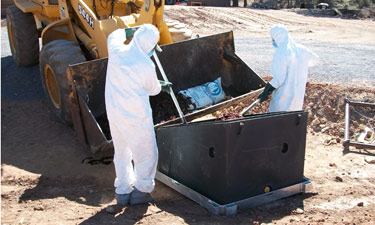 The National Institute for Occupational Safety and Health (NIOSH) conducted a Health Hazard Evaluation (HHE) at a national park. Park management was concerned about employee exposures when cleaning and maintaining pit and composting toilets. NIOSH investigators visited the park to discuss employees’ concerns, observe their work practices and personal protective equipment use, review the park’s written respiratory protection program and material safety data sheets for cleaners and bacteria additives being used, and collect samples. They collected personal breathing zone and area air samples for ammonia, hydrogen sulfide, enteric bacteria (an indicator of fecal contamination), and thermophilic actinomycetes (an indicator of microbial contamination found at the higher temperatures needed to compost organic material).
The National Institute for Occupational Safety and Health (NIOSH) conducted a Health Hazard Evaluation (HHE) at a national park. Park management was concerned about employee exposures when cleaning and maintaining pit and composting toilets. NIOSH investigators visited the park to discuss employees’ concerns, observe their work practices and personal protective equipment use, review the park’s written respiratory protection program and material safety data sheets for cleaners and bacteria additives being used, and collect samples. They collected personal breathing zone and area air samples for ammonia, hydrogen sulfide, enteric bacteria (an indicator of fecal contamination), and thermophilic actinomycetes (an indicator of microbial contamination found at the higher temperatures needed to compost organic material).
NIOSH found higher ammonia concentrations when pit toilets were opened (these dropped quickly upon exposure to the air), compared to when composting toilets were opened. Thermophilic bacteria were present in air samples taken when employees worked with the composting toilets. Hydrogen sulfide and enteric bacteria were not present in the air samples. Investigators noted that work tasks required manual shoveling and lifting and some awkward postures. In addition, employees are at risk for extreme heat, bee and scorpion stings, spider bites, and hantavirus from rodent nests and feces. Lastly, they may be exposed to hepatitis A virus when handling untreated human waste and trash, and to hepatitis B virus while performing other job duties as first responders.
NIOSH provided several recommendations as a result of this evaluation, which are listed below.
What Managers Can Do:
• Add metal brackets to the flat bottom support of the pit toilets to allow the contents to be dumped with a backhoe directly into the landfill storage container for disposal. This reduces employee exposures to untreated human waste and ergonomic hazards of shoveling (See photo, above).
• Increase the frequency of preventive maintenance on toilets to allow issues such as blocked leachate lines to be identified and addressed sooner.
• Start a voluntary vaccination program for hepatitis A and hepatitis B for trail and toilet maintenance crews.
• Develop standard medical follow-up protocols for bee and scorpion stings and spider bites.
• Implement a confined space program for entering and emptying composting toilet vaults. Additional information on working in confined spaces can be found at https://www.cdc.gov/niosh/topics/confinedspace/.
• Start a heat stress program for trail and toilet maintenance crews. A prior NIOSH HHE report gives recommendations for preventing heat stress and strain (see https://www.cdc.gov/niosh/hhe/reports/pdfs/1999-0321-2873.pdf).
What Employees Can Do:
• Wear the correct personal protective equipment for the work you are doing including: gloves, protective clothing, and NIOSH-approved respirator.
• Clean your hands before eating, drinking, or smoking.
• Wait one minute after opening the lid of a pit toilet before servicing it, to allow ammonia levels to dissipate.
• Seek prompt medical care for scorpion stings, bee stings, and spider bites.
• Get vaccinated for hepatitis A virus if you clean and maintain composting toilets and hepatitis B virus if your job involves first aid or potential exposure to bloodborne pathogens.
The entire report of this NIOSH evaluation may be found at:
https://www.cdc.gov/niosh/hhe/reports/pdfs/2009-0100-3135.pdf. For more information on the NIOSH HHE program, see: https://www.cdc.gov/niosh/hhe/HHEprogram.html.
Maureen T. Niemeier, BBA, is a Freelance Technical Writer for National Institute for Occupational Safety and Health (NIOSH), Centers for Disease Control and Prevention. Dr. Nancy Clark Burton, PhD, MPH, CIH and Chad Dowell, MS, CIH are with NIOSH.

